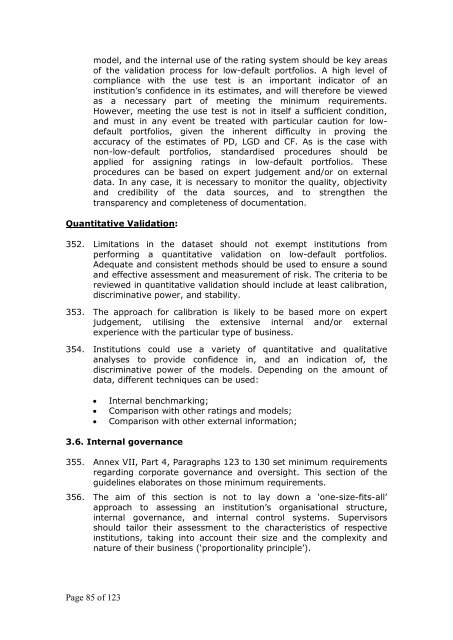CP10 (Full Document) - European Banking Authority
CP10 (Full Document) - European Banking Authority
CP10 (Full Document) - European Banking Authority
Create successful ePaper yourself
Turn your PDF publications into a flip-book with our unique Google optimized e-Paper software.
model, and the internal use of the rating system should be key areas<br />
of the validation process for lowdefault portfolios. A high level of<br />
compliance with the use test is an important indicator of an<br />
institution’s confidence in its estimates, and will therefore be viewed<br />
as a necessary part of meeting the minimum requirements.<br />
However, meeting the use test is not in itself a sufficient condition,<br />
and must in any event be treated with particular caution for lowdefault<br />
portfolios, given the inherent difficulty in proving the<br />
accuracy of the estimates of PD, LGD and CF. As is the case with<br />
nonlowdefault portfolios, standardised procedures should be<br />
applied for assigning ratings in lowdefault portfolios. These<br />
procedures can be based on expert judgement and/or on external<br />
data. In any case, it is necessary to monitor the quality, objectivity<br />
and credibility of the data sources, and to strengthen the<br />
transparency and completeness of documentation.<br />
Quantitative Validation:<br />
352. Limitations in the dataset should not exempt institutions from<br />
performing a quantitative validation on lowdefault portfolios.<br />
Adequate and consistent methods should be used to ensure a sound<br />
and effective assessment and measurement of risk. The criteria to be<br />
reviewed in quantitative validation should include at least calibration,<br />
discriminative power, and stability.<br />
353. The approach for calibration is likely to be based more on expert<br />
judgement, utilising the extensive internal and/or external<br />
experience with the particular type of business.<br />
354. Institutions could use a variety of quantitative and qualitative<br />
analyses to provide confidence in, and an indication of, the<br />
discriminative power of the models. Depending on the amount of<br />
data, different techniques can be used:<br />
· Internal benchmarking;<br />
· Comparison with other ratings and models;<br />
· Comparison with other external information;<br />
3.6. Internal governance<br />
355. Annex VII, Part 4, Paragraphs 123 to 130 set minimum requirements<br />
regarding corporate governance and oversight. This section of the<br />
guidelines elaborates on those minimum requirements.<br />
356. The aim of this section is not to lay down a ‘onesizefitsall’<br />
approach to assessing an institution’s organisational structure,<br />
internal governance, and internal control systems. Supervisors<br />
should tailor their assessment to the characteristics of respective<br />
institutions, taking into account their size and the complexity and<br />
nature of their business (‘proportionality principle’).<br />
Page 85 of 123

















